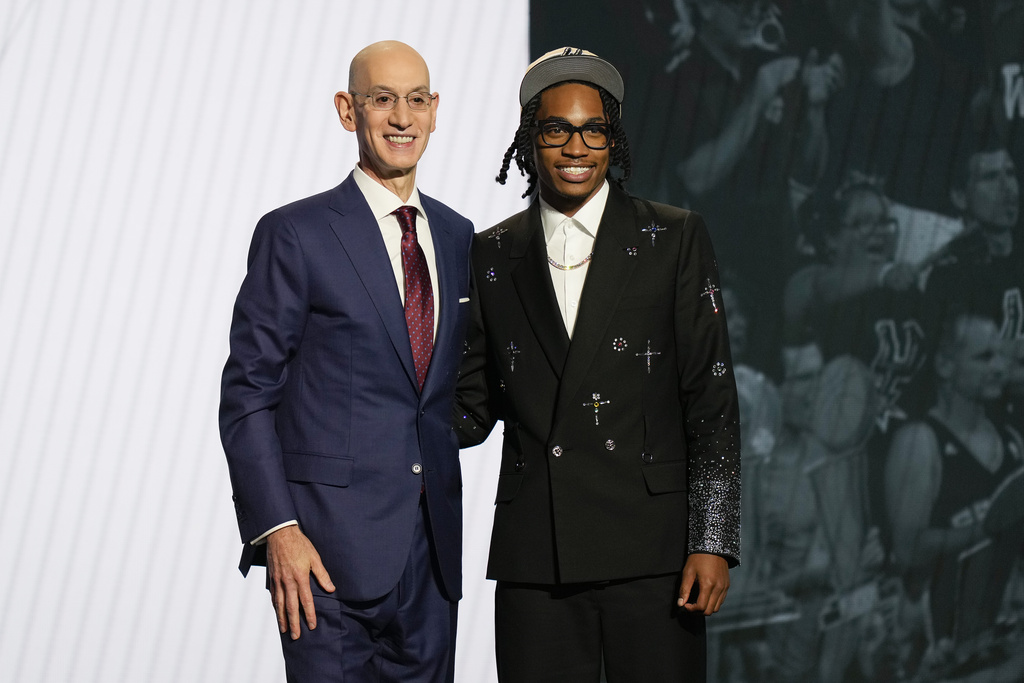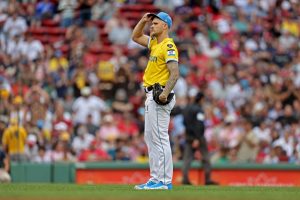
Timberwolves, Spurs draft night trade showed two different approaches with young superstars
The Timberwolves’ draft night trade to leap up into the top 10 of the NBA draft and nab Kentucky point guard Rob Dillingham will likely be studied for years to come, because of what it signaled from the two involved parties.
Minnesota is widely perceived as a major draft night winner, because the Wolves seemingly produced a potential high-end talent in Dillingham — a scintillating 19-year-old scorer who, at his floor, should provide an off-the-bench scoring punch — out of thin air.
And they did so at a time when assets are tough to come by, given Minnesota will now be a second-apron team — strapped with a number of roster management restrictions because of its high salary cap number — that’s largely devoid of draft capital still stemming from the Rudy Gobert trade.
Wolves senior vice president of basketball operations Matt Lloyd said Minnesota’s draft-day maneuver can be a “road map” for other teams in similar circumstances as Minnesota in the future.
“I would opine that (basketball boss Tim Connelly) kind of laid the foundation for teams that are in our position going forward with the aprons and tax exposure and the cap exposure — we had to address needs on the roster with limited resources, so we just utilized the draft as opposed to utilizing free agency or trades,” Lloyd said. “Tim … may have discovered a way for a team in a position like ours to enhance the roster, and it’s via the draft.”
Which is true this week, as Minnesota added Dillingham at No. 8 and Terrence Shannon Jr. at No. 27. But the opportunities to utilize the draft for the Wolves are dwindling.
Moving forward for the next two years — unless it acquires more for someone else — Minnesota can only trade first-round draft picks after it selects the player. Between now and 2032, it only owns first-round picks in even-numbered years. And Utah has rights to a pick swap with Minnesota in 2026, while San Antonio has the same option in 2030.
The latter is part of the deal Minnesota struck on Wednesday. The Wolves got the No. 8 selection from San Antonio in exchange for their 2031 first-rounder and that 2030 pick swap.
What’s interesting about that trade is San Antonio has Victor Wembanyama — a 20-year-old sensation who’s expected to take the mantle as the NBA’s best player sooner than later. The reigning Rookie of the Year exceeded expectations in Year 1 in San Antonio and there’s little reason to think what’s to come won’t be far greater.
But rather than surrounding the 7-foot-4 phenom with the immediate talent required to win big now, the Spurs — who did make a pick at No. 4 overall on Wednesday — instead decided to stockpile more assets down the road.
So, when Wembanyama is 26, the Spurs could potentially move up to grab Minnesota’s 2030 first-round pick if it’s higher up the board. And when the Frenchman is 27 years old, the Spurs will have an additional first-round pick, courtesy of the Wolves.
Teams like the Spurs and Thunder continue to stockpile assets that can be used to either continue cycling young talent into their programs or make big moves down the road to bring in big-named players via trade as their star players approach their primes.
Minnesota pushed that button far earlier. The Wolves took their big swing to get Gobert two years ago, when Edwards was just 20 years old.
It’s tough to say it hasn’t paid off for Minnesota, who just played in the conference finals. The Wolves are currently an NBA title contender.
Every aggressive lever Minnesota pulls in the present will be lauded. If you’re in your championship window, that’s the time to make moves.
What complicates this situation is that Edwards, while already entering NBA superstardom, is still just 22 years old. Four to five years from now — when Edwards is entering his true prime — Minnesota will be void of draft capital. Mike Conley, Kyle Anderson and Rudy Gobert will likely be gone and there still won’t be many avenues to improve the team. Will the Wolves have the ammunition then to contend with the likes of San Antonio and Oklahoma City?
If they’ve won a title by then, the answer may not matter to a fan base starving for a championship. If they haven’t, and the present aggression proves harmful to future contention, the moves Minnesota has made recently may not be recounted as favorably.

